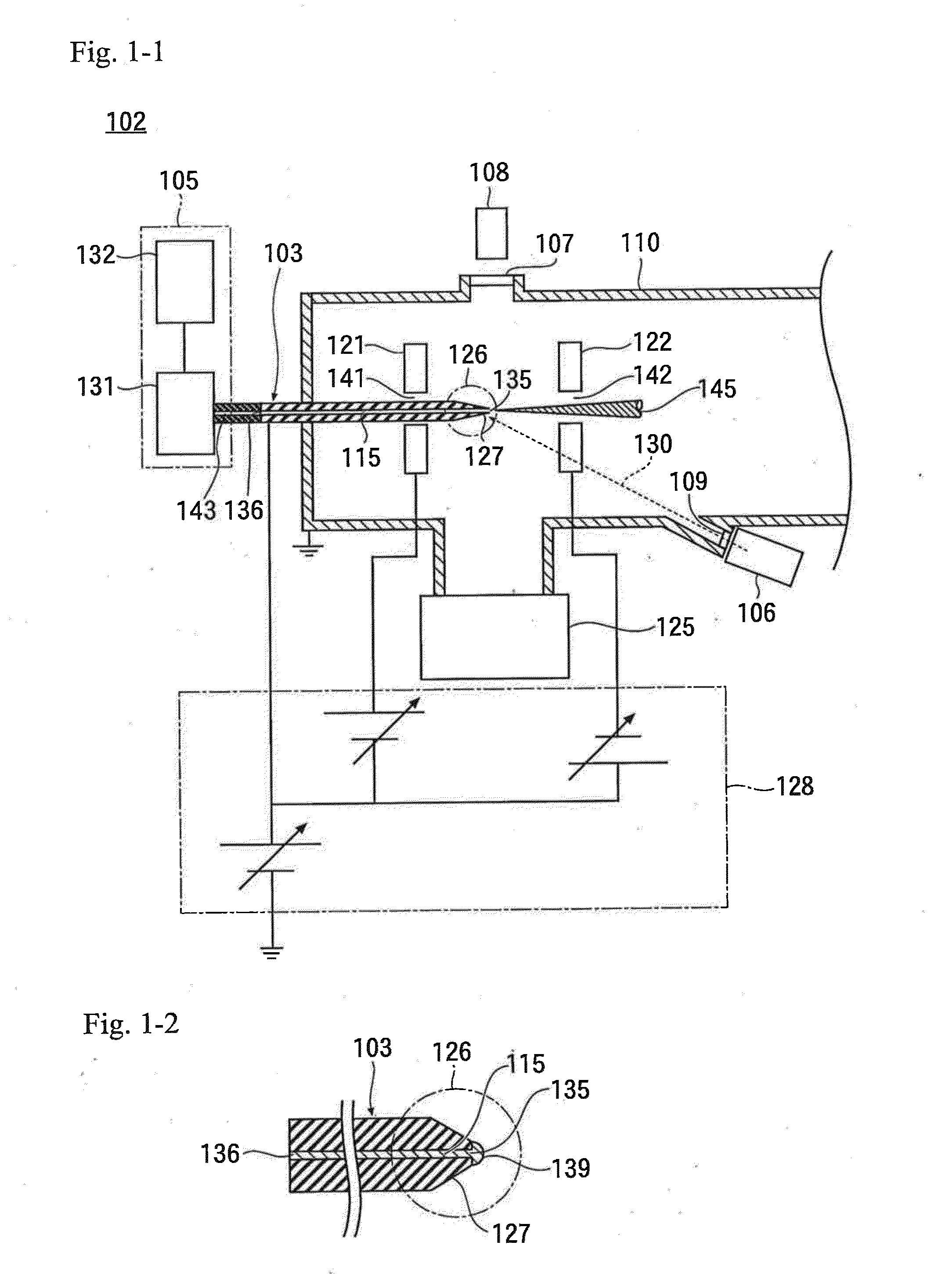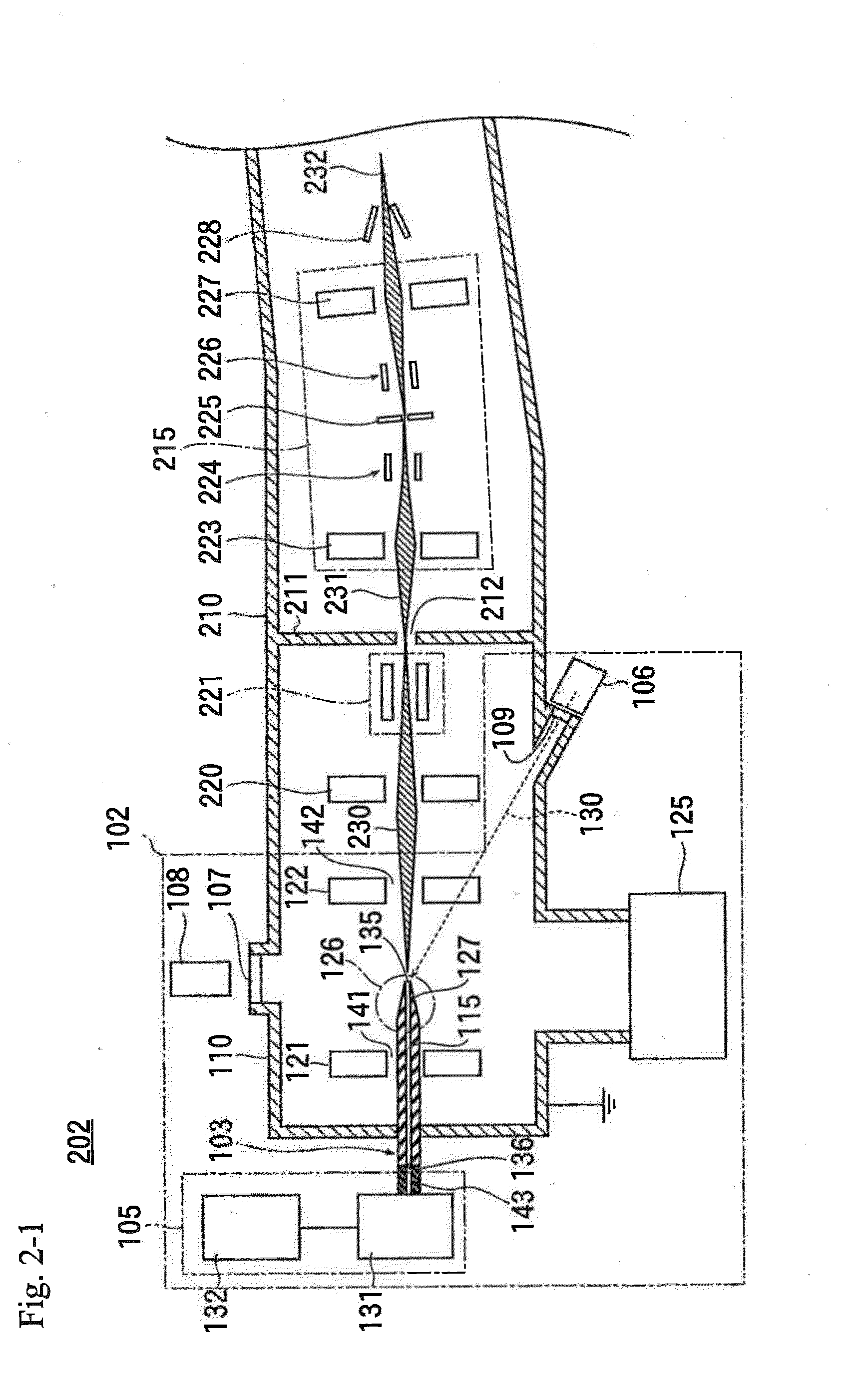Ion source, ion gun, and analysis instrument
a technology of ion gun and analysis instrument, which is applied in the direction of instruments, particle separator tube details, separation processes, etc., can solve the problems of high damage to samples, low secondary ion yield, and high damage due to sputtering, so as to reduce damage to a level acceptable
- Summary
- Abstract
- Description
- Claims
- Application Information
AI Technical Summary
Benefits of technology
Problems solved by technology
Method used
Image
Examples
first embodiment
[0113]FIG. 1-1 illustrates an ion source 102 of the present invention.
[0114]This ion source 102 indicates the use of super large droplet cluster ions (containing a plurality of atoms and molecules in particles having charges), and includes a vacuum chamber 110 and an ionization liquid supply device 105.
[0115]An emission tube 103 is penetrated into a wall of the vacuum chamber 110. One end of the emission tube 103 is positioned outside the vacuum chamber 110; and a distal end portion 126 as the other end is positioned inside the vacuum chamber 110.
[0116]Inside the emission tube 103, a thin tube 115 is formed.
[0117]The ionization liquid supply device 105 includes a liquid storing portion 132 and a liquid feeding pump 131 connected to the liquid storing portion 132.
[0118]The thin tube 115 is connected to a liquid supply pipe 143 at a base part 136 outside the vacuum chamber 110; and the liquid supply pipe 143 is directly connected to the liquid feeding pump 131. The liquid storing port...
second embodiment
[0152]Next, in reference to FIG. 2-1, an ion gun 202 using the above-discussed ion source 102 is described.
[0153]This ion gun 202 is an ion gun for sputtering of a sample surface. A first transport lens electrode 220 and a Wien filter 221 are disposed behind the extracting electrode 122 of the ion source 102. A super large droplet cluster ion beam 230 that has passed through the extracting electrode 122 enters the first transport lens electrode 220 and is focused so that the cluster ion beam can effectively pass through an opening 212 in a partition plate 211 disposed on the downstream side. Next, the cluster ion beam enters the Wien filter 221 and undergoes mass separation so as to be droplet cluster ions having a desired cluster size.
[0154]The partition plate 211 having the opening 212 is disposed on the downstream side of the Wien filter 221. The droplet cluster ions that have passed through the Wien filter 221 irradiate the partition plate 211, and droplet cluster ions 231 selec...
third embodiment
[0161]FIG. 3 illustrates an analysis instrument 302 of the present invention, which is an X-ray photoelectron spectroscopy analysis instrument (XPS) including the above-discussed ion gun 202 so as to perform the X-ray photoelectron spectroscopy using the cluster ion beam.
[0162]This analysis instrument includes an analysis chamber 310, to which a vacuum pump 329 is connected and which is evacuated by the vacuum pump 329; hence, the inside of the analysis chamber 310 is the vacuum environment. Further, the inside of the ion gun 202 is also in a vacuum environment.
[0163]A sample stage portion 320 is disposed inside the analysis chamber 310; and a sample 11 placed on the sample stage portion 320 in the vacuum environment is irradiated with the cluster ion beam232 emitted from the ion gun 202.
[0164]An X-ray emitting device 321 that emits a soft X-ray (such as Al—Kα or Mg—Kα) 331 is disposed at a position facing the sample stage portion 320. A position of the sample 11 irradiated with the...
PUM
| Property | Measurement | Unit |
|---|---|---|
| diameter | aaaaa | aaaaa |
| outer diameter | aaaaa | aaaaa |
| outer diameter | aaaaa | aaaaa |
Abstract
Description
Claims
Application Information
 Login to View More
Login to View More - R&D
- Intellectual Property
- Life Sciences
- Materials
- Tech Scout
- Unparalleled Data Quality
- Higher Quality Content
- 60% Fewer Hallucinations
Browse by: Latest US Patents, China's latest patents, Technical Efficacy Thesaurus, Application Domain, Technology Topic, Popular Technical Reports.
© 2025 PatSnap. All rights reserved.Legal|Privacy policy|Modern Slavery Act Transparency Statement|Sitemap|About US| Contact US: help@patsnap.com



